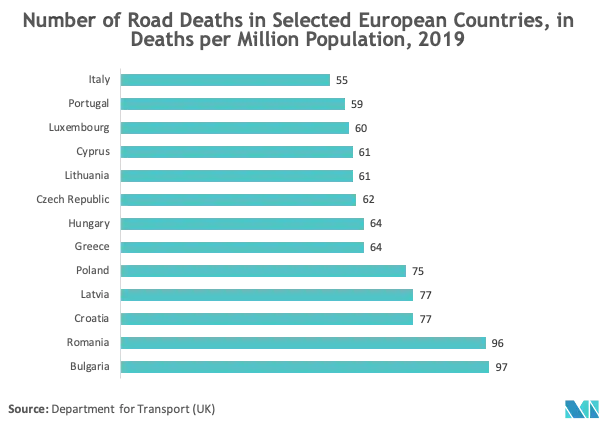Market Trends of Occupant Classification Systems Industry
Passenger Safety and security Regulations and Increased Focus on Compliances to Drive the Market
- The 2030 Agenda for Sustainable Development has set a target for halving the global number of deaths and injuries from road traffic crashes by 2020. Moreover, increasing awareness about the safety of drivers, the increasing influence of safety regulations imposed by the US Department of Transportation, and the European Union are expected to create opportunities for the market. Mandated safety systems, such as electronic stability control (ESC), attained full implementation in new vehicles in major automotive markets. For instance, the United States is currently driving the growth for MEMS accelerometers.
- In March 2019, the European Commission announced a revision of the General Safety Regulations to make autonomous safety technologies a mandatory requirement for vehicles manufactured in Europe, in a bid to bring down accident levels in the region. Stringent regulations are pushing the automotive vendors to implement the latest sensor-based systems. This is creating opportunities for the market.
- Electronic safety systems in the automotive industry have increasingly-stringent requirements. The functional Safety Standard ISO26262 applicable in the automotive industry requires it to ensure that automated systems in cars are safe.

Europe to Witness a Significant Market Growth
- The European automotive sector has ascended to the top of the global industry. It has achieved record sales, and as a major employer and a source of significant grantmaking, it is an integral part of European society. Over the last few decades, the automotive industry in the United Kingdom has been completely transformed. Every 20 seconds, a car, van, bus, or truck rolls off a UK production line. Over 80% of these are exported to more than 100 countries. In the first eleven months of 2019, a total of 2,223,058 passenger cars were sold in Europe, according to the Society of Motor Manufacturers and Traders (SMMT).
- Every year thousands of people lose their life or are seriously injured in accidents on the EU roads. Between 2001 and 2017, the number of road deaths in Europe decreased by 57.5%. Of the total number of fatalities, 46% is accounted for cars and commercial vehicles. Owing to the deaths caused by road fatalities, most of the automobile manufacturers are deploying inertial systems that enhance rider safety.
- Moreover, these fatalities and deaths have also influenced government organizations and institutions to set up strict regulations for the deployment of advanced technology. For instance, the EU institutions have reached a provisional political agreement on the revised General Safety Regulation. As of 2022, new safety technologies will become mandatory in European vehicles to protect passengers, pedestrians, and cyclists.
- The European Commission expects that the proposed measures will help save over 25,000 lives and avoid at least 140,000 serious injuries by 2038. This will contribute to the EU’s long-term goal of moving close to zero fatalities and serious injuries by 2050 (“Vision Zero”). Such regulations are anticipated to boost the market for automotive inertial systems in the region.



